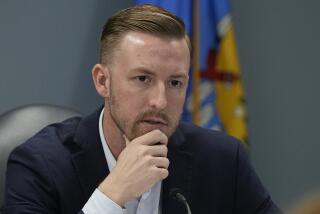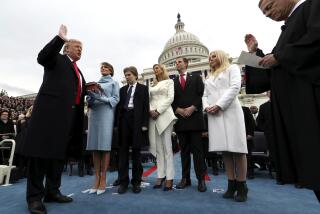Opponents Fear Renewed Push for Prayer in Schools : Constitution: Conservative Republican takeover of House and Senate is expected to fuel battle over 1st Amendment issues. Most religious groups are taking a cautious approach.
- Share via
Religious organizations and 1st Amendment advocacy groups are reacting with a mixture of caution and outright hostility to the growing political push for some form of organized prayer in public schools.
Advocates of strict separation of church and state expect the nation’s public schools to become even more of a battleground over 1st Amendment issues now that conservative Republicans have gained control of the House and Senate.
Rep. Newt Gingrich (R-Ga.), the probable House Speaker in the next Congress, has indicated that he plans to push for an early vote on a constitutional amendment to permit prayer in public schools.
President Clinton heightened the debate this week, first with a conciliatory nod toward the prayer amendment, then by backing away and suggesting that he might support a less divisive “moment of reflection” during the school day.
Both scenarios are potentially problematic to religious groups that believe any form of organized prayer would erode students’ constitutional rights to free expression of religion.
The Supreme Court ruled in 1962 that public school sponsored prayer violated constitutionally mandated church-state separation.
Ten years ago, a Republican-led Senate rejected a proposal for a voluntary school prayer amendment.
A constitutional amendment requires a hard to get two-thirds approval in both the House and Senate, plus ratification by two-thirds of the states.
If a school prayer amendment gained the necessary two-thirds support, said Robert Boston, a spokesman for Americans United for Separation of Church and State, it is likely that the required state approval would follow.
Given the nation’s current conservative political climate, he said, amendment approval would “tear through the states like a brush fire.”
*
It is the prospect of a constitutional change that is raising the strongest objections in the church world. Gingrich backs a proposal, now before Congress, that would allow individual or group prayer in a public school if students are not required to participate and the government does not compose the prayer.
“The result of a school prayer amendment would not be the protection of religious liberty, a value we all cherish, but imposition upon students of obligatory prayers or an embarrassing abstention,” said Alfred H. Moses, president of the American Jewish Committee.
“There is nothing worse for religion than when the government gets too cozy with a particular faith,” said Steve McFarland, director of the Christian Legal Society’s Center for Law and Religious Freedom. “The power to endorse your faith will allow someone else to endorse their faith at your expense.”
Various U.S. Supreme Court decisions have upheld the right of students to pray as individuals or in groups as long as the prayers are not organized by school officials.
Critics of organized prayer claim that under an organized system, peer pressure would intimidate students--particularly adherents of minority religions such as Jews, Hindus and Muslims--into praying even if they did not want to. And by choosing what prayers could be said, critics say administrators would be guilty of “establishment of religion” in violation of the 1st Amendment.
But those opposed to the no-pray policy contend that some school districts have gone too far, unlawfully curtailing all religious expression. They want more guarantees of liberties for religious students written into the Constitution.
“We do not want to go back to how it was before 1963, when the school was setting prayers and Scripture readings,” said Richard D. Land, executive director of the Christian Life Commission of the Southern Baptist Convention. “But we also are not going to accept the dismal situation of the last 30 years, where we have had an attempt to actively or passively censor religious expression on the part of students in our public schools.
“Schools should not sponsor religious activities or give the appearance of either advocating or denigrating religion,” Land added. But “our students are American citizens, and they do not leave their 1st Amendment rights at the boundaries of public school property.”
“We’re talking about students’ right to witness to each other, being able to wear religious jewelry, T-shirts with religious expressions, being able to carry a Bible, to pray over lunch,” he said.
Despite his group’s longstanding support for religious expression in public schools, Land was cautious in his support of any congressionally sponsored prayer amendment. Any support, he said, would “depend on what’s in it.”
*
Land said, nevertheless, that he sees no problem with an amendment allowing public schools to offer students a short period--say, five minutes a day--for “a silent moment of prayer or meditation. Anything beyond that, I get exceedingly nervous with.”
Forest Montgomery, counsel for the conservative National Assn. of Evangelicals based in Carol Stream, Ill., said the current proposal in Congress suffers from the same shortfall that caused his group to oppose a school prayer amendment proposed during the Ronald Reagan Administration in 1982: It would allow school administrators to decide what prayers would be said.
“We would have the same reservations about Caesar getting in the prayer composing business that we had in 1982,” said Montgomery, in a reference to the biblical admonition to “Render unto Caesar that which is Caesar’s and unto God that which is God’s.”
Some of the strongest school prayer support within organized religion appears to come from the American Center for Law and Justice, a legal action group founded by Christian broadcaster Pat Robertson.
Jay Sekulow, lead attorney for the center, has called the drive for a school prayer amendment “almost unstoppable” and said it has been fueled by actions taken by authorities denying students their right to pray in the schools.
Even so, Sekulow said the amendment now in Congress needs to be revised to place more emphasis on student-led prayer.
If caution is the watchword of the school prayer debate, it was quite evident this week at a meeting of the interfaith Coalition for the Free Exercise of Religion, which spans the spectrum from the conservative Concerned Women for America to the liberal National Council of Churches and the Unitarian Universalist Assn.
“I couldn’t find a single lawyer with a conservative organization that supports the amendment as drafted,” Oliver Thomas, chairman of the coalition, said of the coalition meeting.
Cardinal-designate William Keeler of Baltimore, president of the National Conference of Catholic Bishops, on Thursday expressed qualified support for some type of religious expression in the schools.
“Our conference has said that we would be interested in school prayer . . . if it is coupled with instruction in their (students’) own faith,” Keeler said.
He referred to a practice in many school districts in the 1940s and 1950s known as “release time” in which students received religious instruction--either at their public school or some other place--by priests or religious teachers.
But Keeler declined to comment on the proposed congressional amendment. “We don’t comment on legislation until we see the language it would take,” he said.
More to Read
Sign up for Essential California
The most important California stories and recommendations in your inbox every morning.
You may occasionally receive promotional content from the Los Angeles Times.










